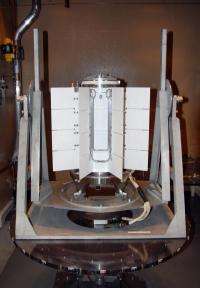Reliable nuclear device to heat, power Mars Science Lab

NASA's Mars Science Laboratory mission, which is scheduled to launch this week, has the potential to be the most productive Mars surface mission in history. That's due in part to its nuclear heat and power source.
When the rover Curiosity heads to space as early as Saturday, it will carry the most advanced payload of scientific gear ever used on Mars' surface. Those instruments will get their lifeblood from a radioisotope power system assembled and tested at Idaho National Laboratory. The Multi-Mission Radioisotope Thermoelectric Generator is the latest "space battery" that can reliably power a deep space mission for many years.
The device provides a continuous source of heat and power for the rover's instruments. NASA has used nuclear generators to safely and reliably power 26 missions over the past 50 years. New generators like the one destined for Mars are painstakingly assembled and extensively tested at INL before heading to space.
"This power system will enable Curiosity to complete its ambitious expedition in Mars' extreme temperatures and seasons," said Stephen Johnson, director of INL's Space Nuclear Systems and Technology Division. "When the unit leaves here, we've verified every aspect of its performance and made sure it's in good shape when it gets to Kennedy Space Center."
The power system provides about 110 watts of electricity and can run continuously for many years. The nuclear fuel is protected by multiple layers of safety features that have each undergone rigorous testing under varied accident scenarios.
The INL team began assembling the mission's power source in summer 2008. By December of that year, the power system was fully fueled, assembled and ready for testing. INL performs a series of tests to verify that such systems will perform as designed during their missions. These tests include:
- Vibrational testing to simulate rocket launch conditions.
- Magnetic testing to ensure the system's electrical field won't affect the rover's sensitive scientific equipment.
- Mass properties tests to determine the center of gravity, which impacts thruster calculations for moving the rover.
- Thermal vacuum testing to verify operation on a planet's surface or in the cold vacuum of space.
The system will supply warmth and electricity to Curiosity and its scientific instruments using heat from nuclear decay. The generator is fueled with a ceramic form of plutonium dioxide encased in multiple layers of protective materials including iridium capsules and high-strength graphite blocks. As the plutonium naturally decays, it gives off heat, which is circulated through the rover by heat transfer fluid plumbed throughout the system. Electric voltage is produced by using thermocouples, which exploit the temperature difference between the heat source and the cold exterior. More details about the system are in a fact sheet here: http://www.inl.gov/marsrover/.
Curiosity is expected to land on Mars in August 2012 and carry out its mission over 23 months. It will investigate Mars' Gale Crater for clues about whether environmental conditions there have favored the development of microbial life, and to preserve any evidence it finds.
NASA chose to use a nuclear power source because solar power alternatives did not meet the full range of the mission's requirements. Only the radioisotope power system allows full-time communication with the rover during its atmospheric entry, descent and landing regardless of the landing site. And the nuclear powered rover can go farther, travel to more places, last longer, and power and heat a larger and more capable scientific payload compared to the solar power alternative NASA studied.
"You can operate with solar panels on Mars, you just can't operate everywhere," said Johnson. "This gives you an opportunity to go anywhere you want on the planet, not be limited to the areas that have sunlight and not have to put the rover to sleep at night."
Provided by Idaho National Laboratory





















